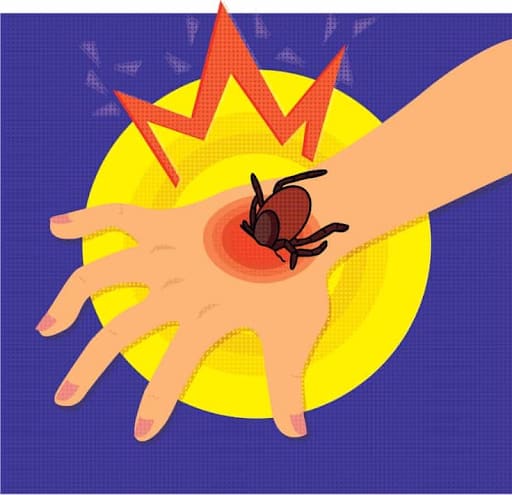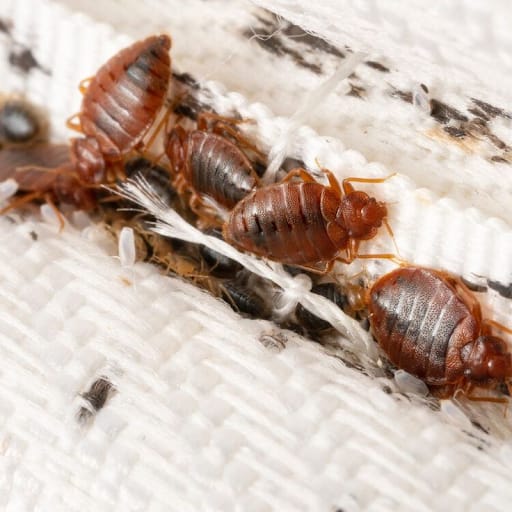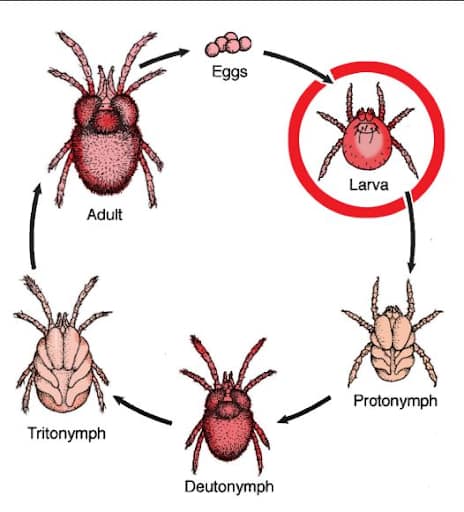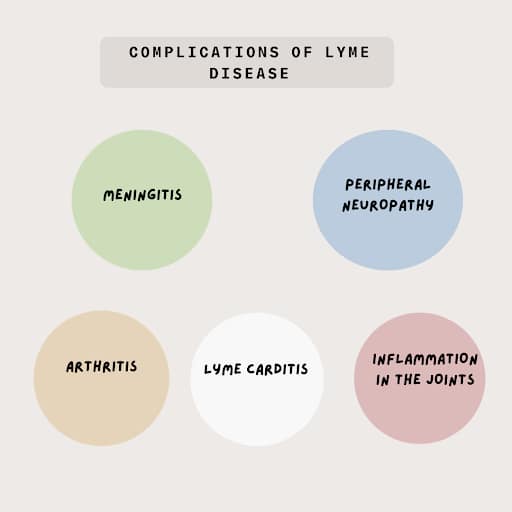
When you detect an itchy bite on your skin, you will panic, thinking about Lyme disease. Clinically, the bite gives the appearance of bull’s eye rashes. You will have a tendency to associate Lyme disease with chiggers, bed bugs, and spiders.
Do these insects cause Lyme disease? It is important to distinguish between insect bites for proper management. In this blog, we will explore whether chiggers, bed bugs, or spiders are responsible for transmitting Lyme disease.
Do bed bugs carry Lyme disease?

When compared to other pests, bed bugs will not transmit any disease. These insects feed on human blood for survival. These pests inject saliva during feeding, but will not transmit any pathogens. One of the major complications associated with bed bug bites is the occurrence of secondary infections.
While scratching, the skin breaks and serves as a portal for bacterial entry. This can result in various infections, such as cellulitis and impetigo. Antibiotics are required if the bites become infected. It has been estimated that bed bugs cannot spread any disease to human beings.
Bed bugs can result in an allergic reaction, known as urticaria, which is characterized by inflammation and swelling. Gradually, these rashes can become fluid-filled.
Do chiggers carry Lyme disease?
Chiggers will not transmit Lyme disease in human beings. Chiggers are tiny larvae, measuring 0.3 -1mm that belong to the Thrombiculidae family. There is a possibility of chigger bites when an individual walks in grasses or woodlands.
There is an increased chance of pest infestation on major sites, such as the ankles or the waist. When the chigger bites, an allergic reaction can occur, resulting in red papules.
If detected, chiggers can be removed with soap & water. The major treatment is to control the clinical symptoms of itching by applying calamine solution. Corticosteroids or oral antihistamines can also be used to control the symptoms.

Do spiders carry Lyme disease?

Spiders cannot transmit Lyme disease. Some individuals develop an allergic reaction when bitten by a spider, resulting in the formation of blisters. Certain spiders can produce toxic venom that can affect your health.
The clinical symptoms of a spider bite include: (4)
- Burning sensation or itching at the site of the bite that develops within hours or days.
- Presence of skin rashes
- Formation of blisters
- Swelling in the eyelids
- Cramping pain in the stomach and back region
- Fever
- Vomiting
What is the difference between a spider bite and a tick bite?
Spiders bite humans as a result of a defense mechanism. Spider bites can result in clinical symptoms, such as swelling, pain, and redness at the particular site. They can also cause chronic symptoms that require emergency care. Common sites include exposed areas, such as arms or legs. Mostly, spider bites do not cause serious harm. Few spiders are considered venomous. Eg: Brown Recluse.
Tick bites are painless, resulting in the formation of skin rashes. The skin rashes can appear as concentric rings, giving a bull’s eye appearance. Rashes will not manifest in every individual. In some individuals, clinical symptoms appear as:
- Headache
- Bell’s palsy (Paralysis of the facial nerve)
- Tingling sensation
- Brain fog
- Swollen lymph nodes
- Tenderness in the joint region
How does Lyme disease spread?
Lyme disease is caused by the bacteria “Borrelia burgdorferi”. The ticks must be attached to the host surface for more than 24 hours to spread the infection. Nymphs (immature ticks) are considered the major source of transmission in human beings.
Nymphs are smaller when compared to adult ticks. The clinical signs may start to appear within 1-2 weeks after the tick bite.
At the site of a tick bite, tiny red bumps can develop. Slowly, these bumps develop into concentric bull’s eye rashes. In some cases, bacterial infection can spread to the cardiovascular system or central nervous system.
How to manage insect bites?
| Bed bug | Chigger | Tick | Spider |
|---|---|---|---|
| Clean the area thoroughly. | Wash the area with soap & water | Once detected, use tweezers to remove the ticks immediately. | Apply ice packs to relieve the pain and swelling. |
| Medical attention is needed in case of infection or an allergic reaction. | Medical help is required if there is persistent scratching, leading to secondary infections. | Medical attention is needed in case of systemic symptoms, such as joint pain, fever, etc. | Medical attention is needed in case of systemic symptoms, such as joint pain, fever, etc. It is important to consult the doctor if there is persistent pain and swelling. |
| Take oral antihistamines to control the clinical symptoms or apply topical steroids | Application of calamine lotion or hydrocortisone. | If there is persistent itching, continue antihistamines | NSAIDs can be prescribed to relieve the pain. |
Why is the bull’s eye rash linked with only Lyme disease?
Bull’s eye rashes are considered an early symptom of Lyme disease and are not associated with any other insect bite. These rashes occur due to the infection caused by the bacteria “Borrelia burgdorferi”.
When the tick remains attached to the host surface for more than 24 hours, bacteria enter the skin and proliferate. There will be an immune response of the body against bacterial invasion.

As a result, concentric rashes can occur, resembling a bull’s eye. According to the Center for Disease Control and Prevention, these types of rashes occur in 70-80% of the individuals. Other insects, such as bed bugs, chiggers and spiders can result in blisters or red bumps, but not these target-shaped rashes.
Hence, bull’s eye rash is a characteristic pattern, which is typically found in Lyme disease. It is important to detect these rashes for initiating prompt treatment. If the condition is not treated, several complications may occur, such as:
- Meningitis
- Peripheral neuropathy
- Lyme carditis
- Arthritis
- Inflammation in the joints

Conclusion
- Chiggers, bed bugs, ticks, and spiders can cause an allergic reaction but will not spread Lyme disease.
- Proper knowledge about insect bites and clinical symptoms can aid in management and prevent further complications.
- In the case of Lyme disease, it is important to monitor the clinical symptoms to ensure timely intervention.
References
- Can Bed Bugs Transmit Diseases? Separating Myths from Facts. Pest.co.uk [Internet]. 23 Sep 2024 [cited 2025 Jun 17]. Available from: https://pest.co.uk/2024/09/23/can-bed-bugs-transmit-diseases-separating-myths-from-facts
- Rao C, Chen Z, Arlian LG, et al. Investigating the association of bed bugs with infectious diseases: A … [Internet]. 2022 [cited 2025 Jun 17]; Available from: https://www.ncbi.nlm.nih.gov/pmc/articles/PMC8569396
- Powers J, McDowell RH. Insect Bites [Internet]. Treasure Island (FL): StatPearls Publishing; 2019 Feb 7 [cited 2025 Jun 17]. Available from: https://www.ncbi.nlm.nih.gov/books/NBK537235
- Spider Bites. Johns Hopkins Medicine [Internet]. [cited 2025 Jun 17]. Available from: https://www.hopkinsmedicine.org/health/conditions-and-diseases/spider-bites


